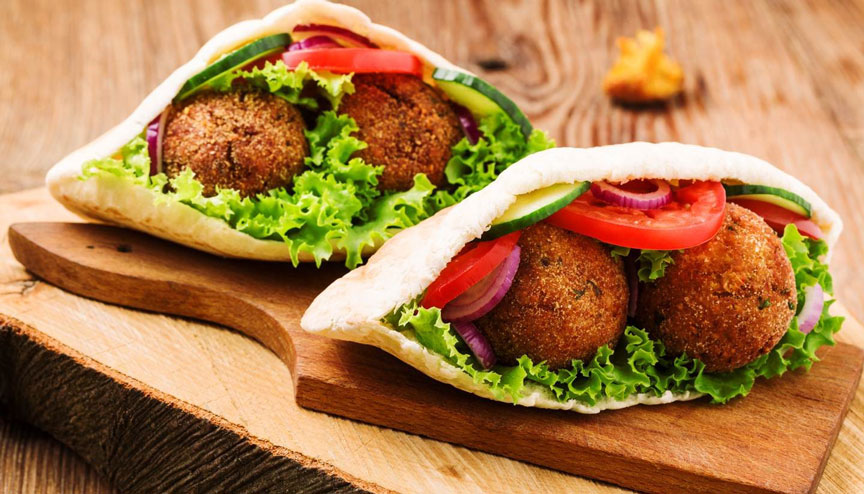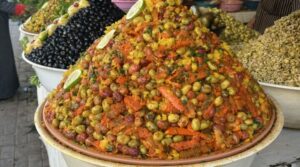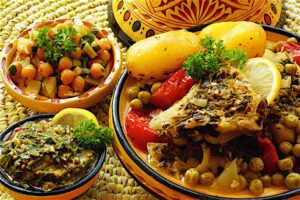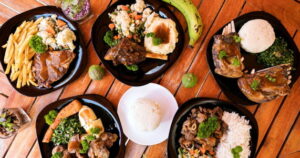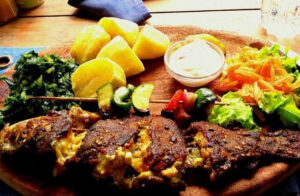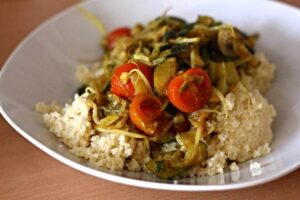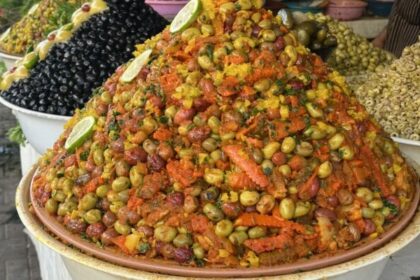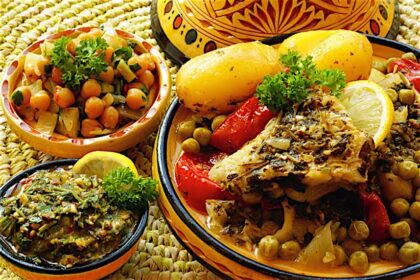Table of Contents
Africa’s vibrant tapestry of cultures and flavours beckons travelers to embark on a culinary journey like no other. In the heart of this cultural mosaic lies Egypt, a land steeped in history and renowned for its exquisite cuisine. From the bustling streets of Cairo to the tranquil shores of the Red Sea, Egypt offers a tantalizing array of food and drink that tantalizes the taste buds and warms the soul.
Read on to discover the best dishes and beverages to try in Egypt, exploring the rich culinary heritage that makes Egyptian cuisine a culinary delight. Prepare to uncover the flavours, aromas, and traditions that define Egypt’s gastronomic landscape and discover why it is a must-visit destination for food enthusiasts around the world.
Egypt, with its rich culinary heritage, offers a delightful array of flavours and dishes. Explore some of the best traditional Egyptian food and drinks you shouldn’t miss:
1. Fuul Medames
2. Ta’amiyya (Falafel)
3. Mahshi
4. Konafa
5. Egyptian Tea (Shai)
Overview of Africa Tourism – Best Food & Drink to Try In Egypt (And Why)
How to Choose Africa Tourism – Best Food & Drink to Try In Egypt (And Why)
Pros & Cons of Africa Tourism – Best Food & Drink to Try In Egypt (And Why)
What to Watch Out For…
Pro Tips
Recap
1. Fuul Medames
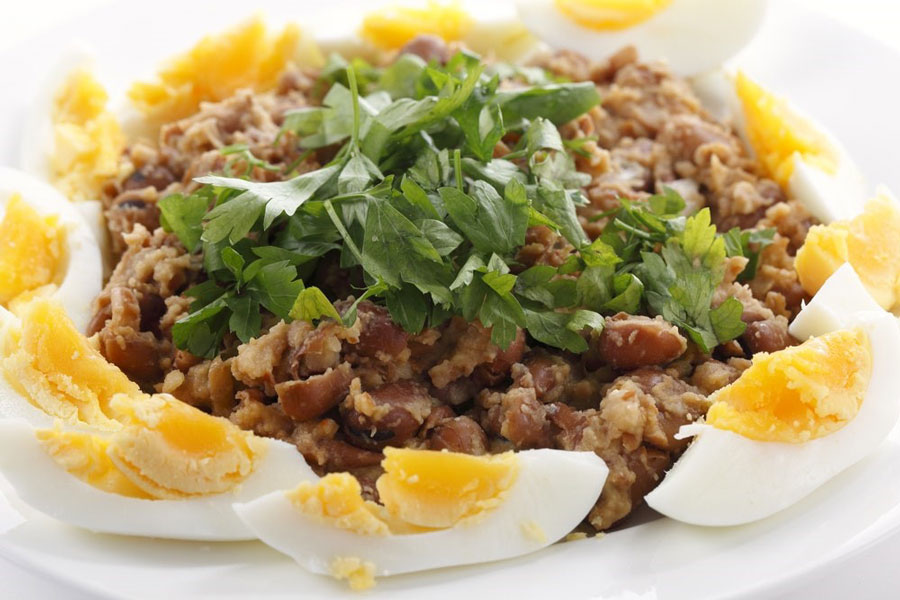
Egypt’s national dish, fuul medames, is a simple yet nutritious breakfast or dinner option. Slow-cooked fava beans are seasoned with olive oil, cumin, and spices. Some variations include parsley, chili, lemon juice, and garlic. Enjoy it in sandwiches or with bread. Locals often add tahini or boiled eggs to customize their fuul medames experience. Fuul Medames has an iconic status in Egyptian cuisine. This hearty dish of cooked fava beans seasoned with garlic, lemon juice, and olive oil represents the essence of Egyptian comfort food. Its simplicity, rich flavor, and nutritional value make it a beloved staple for locals and a must-try for visitors seeking an authentic taste of Egypt.
- Nutritional Benefits: Fuul Medames is rich in protein, fiber, and essential nutrients, contributing to a balanced and healthy diet..
- Cultural Significance: Fuul Medames holds cultural significance in Egyptian cuisine, serving as a traditional breakfast staple and symbolizing communal dining experiences.
- Acquired Taste: Its unique flavor and texture may not appeal to all palates, requiring some individuals to develop a taste for it over time.
- Gas Production: Fuul Medames can cause flatulence and digestive discomfort in some people due to its high fiber content.
- Ingredients: Fuul Medames is made from cooked fava beans seasoned with garlic, lemon juice, olive oil, and various spices such as cumin.
- Preparation: The fava beans are typically soaked overnight, boiled until tender, and then mashed or left whole, depending on preference.
- Serving: Fuul Medames is commonly served warm with toppings such as chopped tomatoes, onions, hardboiled eggs, and a drizzle of olive oil. It is often accompanied by flatbread or pita for dipping.
- Variations: There are regional variations of Fuul Medames across the Middle East and North Africa, with differences in seasoning and garnishes.
2. Ta’amiyya
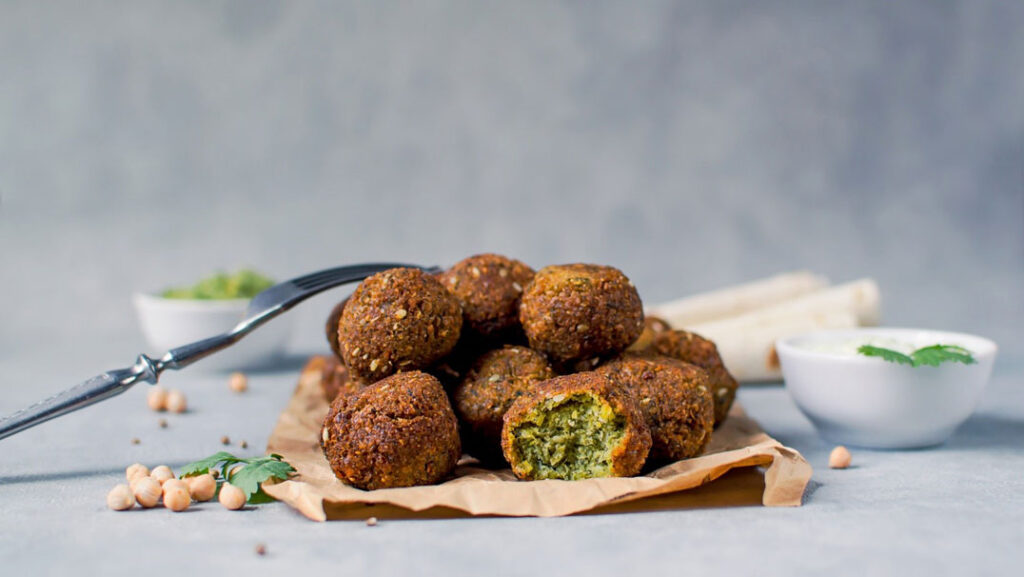
Ta’amiyya, or falafel, made it for its popularity as a quintessential Egyptian street food. These deep-fried balls of ground fava beans or chickpeas are bursting with flavor and offer a satisfying crunch on the outside and a soft, flavorful center. Ta’amiyya showcases Egypt’s vibrant street food culture and is a delicious and convenient option for you exploring the bustling streets of Cairo and beyond. Egyptian ta’amiyya is fluffier and includes parsley, coriander leaves, and spices. Enjoy it in a sandwich with mixed salad and tahini. Check out Tabali Bistro in western Cairo for a tasty ta’amiyya experience.
- Versatility: Ta’amiyya can be enjoyed in various forms, such as sandwiches, wraps, salads, or as a standalone snack, offering versatility in serving options.
- Street Food Culture: Ta’amiyya is a quintessential street food in Egypt, reflecting the vibrant culinary scene and providing convenient and affordable options for on-the-go-dining.
- High Caloric Content: Depending on the preparation method, Ta’amiyya can be high in calories and fat, especially when deep-fried, which may not be suitable for individuals watching their calorie intake.
- Potential Cross Contamination: Cross contamination with other fried foods or allergens may occur in shared fryers, posing risks for individuals with dietary restrictions or food allergies.
- Ingredients: Ta’amiyya is made from ground fava beans or chickpeas mixed with herbs, spices, and binding agents such as flour or breadcrumbs.
- Preparation: The mixture is formed into small balls or patties and deep-fried until golden brown and crispy on the outside, while remaining soft and flavorful on the inside.
- Serving: Ta’amiyya is commonly served as a filling for sandwiches or wraps, accompanied by salads, pickles, and tahini sauce. It can also be enjoyed as a standalone snack.
- Popularity: Ta’amiyya is a popular street food in Egypt and throughout the Middle East, often sold by vendors from roadside stalls or food carts.
3. Mahshi
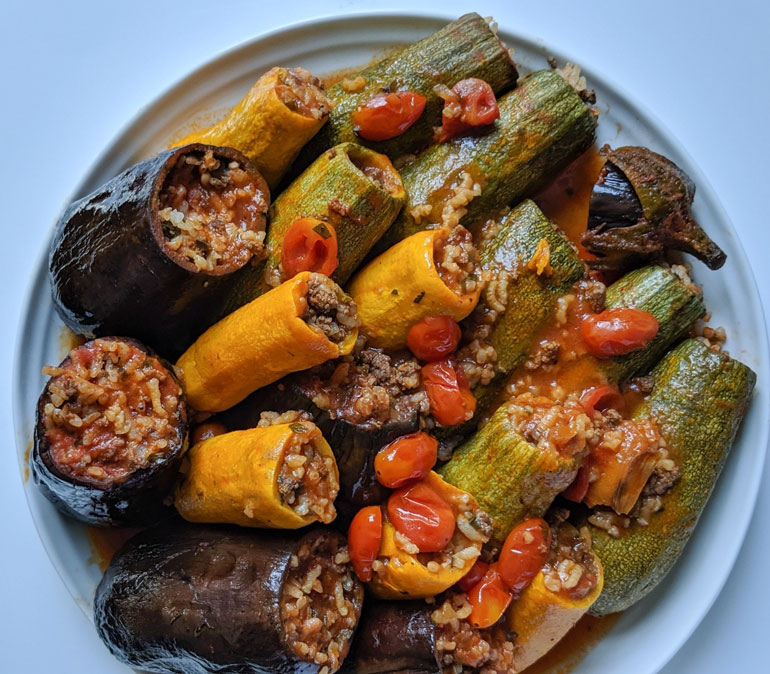
Mahshi captured our attention for its versatility and delicious flavors. This dish, which refers to various stuffed vegetables such as vine leaves or peppers, is filled with a savory mixture of rice, herbs, and sometimes minced meat. Mahshi dishes offer a burst of flavors and textures, reflecting Egypt’s culinary creativity and the use of fresh, seasonal ingredients. Whether enjoyed as a side dish or a main course, Mahshi is a delightful addition to any Egyptian meal. Stuffed vegetables (eggplant, bell pepper, zucchini squash, cabbage, or grape leaves) filled with minced meat and rice, seasoned with various spices, and often cooked in lamb, beef, or chicken broth with lemon juice.
- Versatility: Mahshi offers a wide variety of options with stuffed vegetables ranging from vine leaves to peppers, providing options for different tastes and preferences.
- Flavorful: Mahshi dishes are filled with a savory mixture of rice, herbs, and sometimes minced meat, offering a burst of flavors and textures that appeal to many palates.
- Labor-intensive Preparation: Mahshi dishes can be time-consuming to prepare, requiring intricate stuffing and cooking processes, which may deter busy individuals or those seeking quick meals.
- Availability of Ingredients: Finding fresh or frozen Mahshi ingredients, such as vine leaves or specific vegetables, outside of regions where they are commonly grown may be difficult, limiting accessibility for international cooks.
- Ingredients: Mahshi refers to various stuffed vegetables such as vine leaves, peppers, zucchini, or cabbage, filled with a savory mixture of rice, herbs, and sometimes minced meat.
- Preparation: The vegetables are hollowed out and stuffed with the rice mixture, then cooked in a flavorful broth or tomato sauce until tender.
- Serving: Mahshi is typically served hot as a main dish or side dish, accompanied by yogurt or tahini sauce, and may be garnished with fresh herbs or lemon wedges.
- Variations: There are countless variations of Mahshi across the Middle East and North Africa, with different vegetables and fillings used based on regional preferences.
4. Konafa

Konafa: It has irresistible combination of textures and flavours. This delightful dessert features thin, noodlelike pastry layers soaked in sweet syrup, creating a delectable treat that satisfies the sweet tooth. Stuffed with creamy cheese and often topped with crunchy nuts, Konafa offers a perfect balance of sweetness and richness, making it a beloved dessert in Egyptian cuisine and a must try for anyone with a penchant for indulgent sweets. A delightful dessert made from thin, noodlelike pastry soaked in syrup, stuffed with creamy cheese, and often topped with nuts.
- Indulgent Dessert: Konafa is a deliciously sweet and indulgent dessert that satisfies the sweet tooth with its layers of crispy pastry, creamy filling, and syrupy sweetness.
- Celebratory: Konafa is a popular dessert served during special occasions and celebrations in Egypt and throughout the Middle East, adding a festive touch to gatherings and events.
- Caloric Density: Due to its high sugar and fat content from ingredients like cheese, nuts, and syrup, Konafa can be calorie dense, potentially contributing to weight gain if consumed excessively.
- Complexity of Preparation: Making Konafa from scratch requires skill and patience, as it involves layering delicate pastry and filling, as well as soaking in syrup, which may be challenging for novice cooks.
- Ingredients: Konafa is made from shredded phyllo dough or semolina dough layered with sweet cheese or nuts, soaked in a sugary syrup flavored with rose water or orange blossom water.
- Preparation: The dough is layered in a baking dish, with the filling placed in the center or between layers, then baked until golden and crispy.
- Serving: Konafa is typically served warm, often cut into squares or slices, and may be garnished with additional nuts, powdered sugar, or cinnamon.
- Occasions: Konafa is a popular dessert served during special occasions and celebrations in Egypt and throughout the Middle East.
5. Egyptian Tea (Shai)
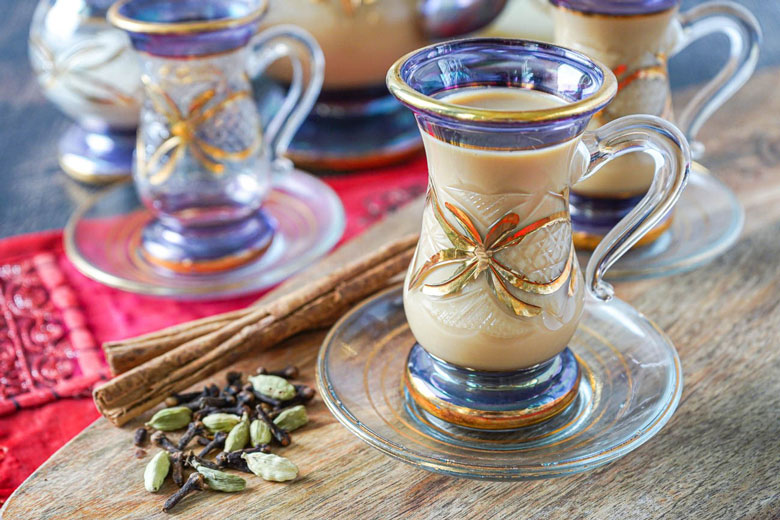
Egyptian Tea, or Shai, made it onto our list for its cultural significance and refreshing taste. Served with sugar, Egyptian tea comes in two main varieties: golden koshary tea in the north, often flavored with mint for added freshness, and dark saiidi tea in the south. Whether enjoyed hot or cold, Egyptian tea offers a comforting and invigorating beverage option that reflects the warmth and hospitality of Egyptian culture. Additionally, herbal teas are popular alternatives, providing a diverse range of flavours and health benefits for tea enthusiasts to explore. Served with sugar, Egyptian tea comes in two basic varieties: golden koshary tea in the north (often with mint) and dark saiidi tea in the south. Herbal teas are also popular.
- Cultural Significance: Egyptian tea, or Shai, holds significant cultural importance in Egyptian society, often serving as a symbol of hospitality and warmth in social gatherings and celebrations.
- Refreshing: Served hot or cold, Egyptian tea offers a comforting and refreshing beverage option that provides a moment of relaxation and enjoyment throughout the day.
- Caloric Content: Depending on the amount of sugar added, Egyptian tea can be high in calories, especially when consumed frequently throughout the day, which may contribute to weight gain if not consumed in moderation.
- Caffeine Content: While moderate consumption of caffeine can have benefits, excessive intake of Egyptian tea, particularly for individuals sensitive to caffeine or those with certain health conditions, may lead to adverse effects such as insomnia, jitteriness, or increased heart rate.
- Varieties: Egyptian tea, known as Shai, comes in two main varieties: golden koshary tea in the north, often served with mint for added freshness, and dark saiidi tea in the south.
- Preparation: The tea leaves are steeped in hot water, often flavored with mint, lemon, or spices such as cinnamon or cardamom, and sweetened to taste with sugar.
- Serving: Egyptian tea is typically served hot in small glass cups, often accompanied by sweet pastries or cookies, and is enjoyed throughout the day as a social beverage.
PRO TIPS >>> Best Tourist Destinations in North Africa
Overview of Africa Tourism Best Food & Drink to Try In Egypt (And Why):
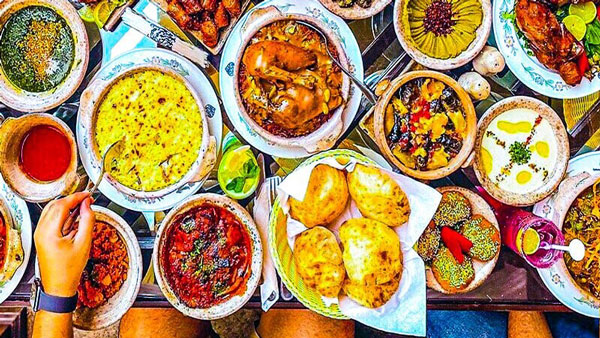
Experience the culinary delights of Egypt, where ancient traditions blend with vibrant flavors to create a unique gastronomic experience. From hearty street food to exquisite dishes fit for royalty, Egypt offers a diverse array of food and drink that tantalizes the senses and reflects the country’s rich history and cultural heritage. Indulge in aromatic spices, succulent meats, and freshly baked bread as you embark on a culinary journey through this fascinating land.
How to Choose Africa Tourism Best Food & Drink to Try In Egypt (And Why)
When selecting the best food and drink to try in Egypt, consider exploring traditional dishes that showcase the country’s culinary diversity and heritage. Look for local eateries and street vendors known for their authenticity and use of fresh, locally sourced ingredients. Be adventurous and open-minded, trying a variety of dishes ranging from classic favourites like Koshari and falafel to lesser known specialties such as molokhia and kofta. Engage with locals to learn about their favourite food spots and recommendations, and don’t forget to pair your meals with refreshing beverages like hibiscus tea or sugarcane juice for an authentic Egyptian dining experience.
Pros & Cons of Africa Tourism Best Food & Drink to Try In Egypt (And Why)
Pros
- It provides a rich cultural experience, allowing you to immerse yourself in the country’s culinary heritage.
- It offers a diverse array of flavours and dishes, ranging from traditional street food to elaborate feasts, catering to various tastes and preferences.
- It allows you to taste authentic Egyptian flavours, prepared using traditional methods and locally sourced ingredients.
Cons
- It has potential health risks due to poor hygiene standards.
- It often contains unfamiliar ingredients or flavours that may not appeal to all palates.
- It is expensive to dining at upscale restaurants or tourist oriented establishments in Egypt.
What to Watch Out For

When indulging in Egypt’s culinary delights, you should be cautious of food hygiene and sanitation practices, particularly when dining at street stalls or small eateries. Avoid consuming raw or undercooked meats, and opt for freshly prepared dishes whenever possible. Be mindful of food allergies and sensitivities, and inquire about ingredients and cooking methods to ensure a safe dining experience. Additionally, stay hydrated and avoid tap water, opting for bottled or boiled water instead.
GET SMARTER >>> Africa Tourism – Best Destinations for Families
Pro Tips
- Research: Prior to your trip, research popular Egyptian dishes and dining etiquette to familiarize yourself with the local cuisine and customs.
- Stay Hydrated: Drink plenty of bottled or boiled water to stay hydrated, especially in hot climates, and avoid consuming tap water.
- Street Food Caution: When sampling street food, choose vendors with clean and hygienic food preparation practices, and opt for freshly cooked dishes.
- Local Recommendations: Seek recommendations from locals or fellow travelers for authentic dining experiences off the beaten path, away from tourist areas.
- Dietary Considerations: If you have dietary restrictions or allergies, learn how to communicate them in Arabic or carry a translated card to ensure your needs are understood by restaurant staff.
- Try Everything: Be adventurous and try a variety of dishes, including local specialties and regional variations, to fully experience the richness of Egyptian cuisine.
Recap
When you explore the best food and drink in Egypt, you embark on a delightful journey through the country’s rich culinary heritage. From savoring traditional street food to indulging in sumptuous feasts fit for royalty, Egypt’s diverse cuisine tells a story of its long history and cultural influences.
While there are risks associated with dining in unfamiliar environments, you can minimize these by practicing caution and choosing reputable establishments. By embracing the opportunity to try new flavours and dishes, you’ll create lasting memories and develop a deeper appreciation for Egypt’s vibrant food culture.





